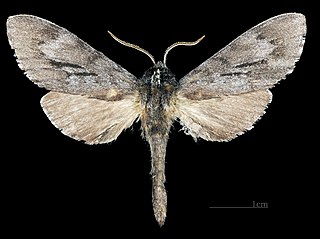
Lapara coniferarum, the southern pine sphinx, is a species of sphinx moth. It was first described by James Edward Smith in 1797. The species is listed as threatened in Connecticut.

Acronicta lanceolaria, the lanceolate dagger moth or pointed dagger, is a moth of the family Noctuidae. The species was first described by Augustus Radcliffe Grote in 1875. It is found in North America, from Nova Scotia to British Columbia. It is listed as a species of special concern and believed extirpated in the US state of Connecticut.

Euchlaena is a genus of moths in the family Geometridae erected by Jacob Hübner in 1823.

Eumacaria is a monotypic moth genus in the family Geometridae described by Packard in 1873. Its only species, Eumacaria madopata, the brown-bordered geometer moth, was first described by Achille Guenée in 1857. It is found in North America, where it has been recorded from British Columbia, northern Washington, southern Saskatchewan, from Maine to Florida, South Dakota, North Dakota, Nebraska, Wyoming, Idaho, Colorado and New Mexico. The habitat consists of orchards and shrublands. The species is listed as threatened in Connecticut.
Abagrotis nefascia is a moth of the family Noctuidae first described by Smith in 1908. It is found in North America from Alberta and British Columbia down through Massachusetts to California. The species is listed as threatened in the US state of Connecticut.

Acronicta fragilis, the fragile dagger moth, is a moth of the family Noctuidae. The species was first described by Achille Guenée in 1852. It is found in North America from Newfoundland to Florida, west across Canada, south to Kentucky and Minnesota. It is listed as a species of special concern in the US state of Connecticut.

Agrotis stigmosa is a moth of the family Noctuidae first described by Herbert Knowles Morrison in 1875. It is found in North America from New England and Quebec west to Colorado and eastern Alberta. It is listed as a species of special concern in the US state of Connecticut.
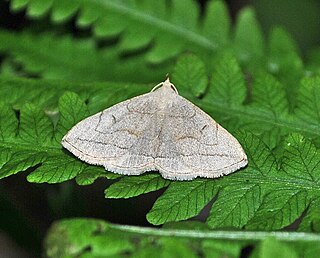
Zanclognatha pedipilalis, the grayish zanclognatha, is a litter moth of the family Erebidae. The species was first described by Achille Guenée in 1854. It is found in eastern North America, from Nova Scotia south to Florida and Mississippi, west to Alberta and Kansas.
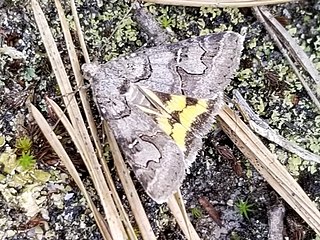
Drasteria graphica, the graphic moth, is a moth of the family Erebidae. The species was first described by Jacob Hübner in 1818. It is found in the United States in coastal dunes from Maine to Florida, west to Mississippi. It is also found along the shores of the Great Lakes in Michigan and Wisconsin. Subspecies D. g. atlantica is listed as threatened in Connecticut.
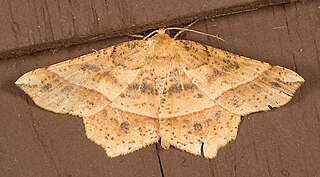
Euchlaena tigrinaria, the mottled euchlaena, is a moth of the family Geometridae. The species was first described by Achille Guenée in 1857. It is found from New Brunswick to Virginia, west to Texas, Utah and Oregon, north to British Columbia.

Euchlaena amoenaria, the deep yellow euchlaena, is a moth of the family Geometridae. It is found in eastern North America.

Apantesis phyllira, the phyllira tiger moth, is a moth of the family Erebidae. It was described by Dru Drury in 1773. It is found in North America from Quebec and New England south to Florida and west to Texas, Colorado and Alberta. The habitat consists of dry, open woodland and grassland. The species is listed as endangered in Connecticut.
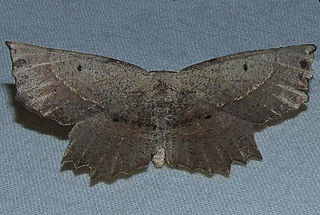
Euchlaena obtusaria, the obtuse euchlaena moth, is a moth of the family Geometridae. The species was first described by Jacob Hübner in 1813. It is found in North America, where it has been recorded from Alberta east to Nova Scotia, south to Florida and Texas. The habitat consists of mixed wood forests.

Euchlaena deplanaria is a species of moth of the family Geometridae. It is found in North America, where it has been recorded from Colorado to Massachusetts and south to Florida and Texas.

Euchlaena deductaria, the forked euchlaena moth, is a species of moth of the family Geometridae. It is found in North America, where it has been recorded from Alabama, Arkansas, Florida, Georgia, Kentucky, Maine, Maryland, New York, North Carolina, Ohio, Oklahoma, South Carolina, Tennessee, Texas and West Virginia.

Euchlaena muzaria, the muzaria euchlaena moth, is a species of moth of the family Geometridae. It is found in North America, where it has been recorded from Florida, Kentucky, Maine, Maryland, Massachusetts, Minnesota, New Brunswick, New Hampshire, New York, North Carolina, Ohio, Ontario, South Carolina and Tennessee.
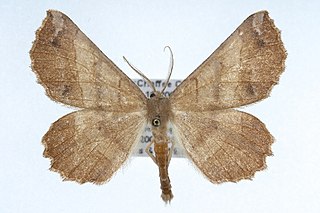
Euchlaena johnsonaria, or Johnson's euchlaena moth, is a moth of the family Geometridae. The species was first described by Asa Fitch in 1870. It is found in North America, where it has been recorded from southern coastal British Columbia east to Nova Scotia, south to New Jersey, Missouri and Oregon. The habitat consists of deciduous wooded areas.
Chaetaglaea cerata, the waxed sallow, is a species of moth in the family Noctuidae described by John G. Franclemont in 1943. It is found in North America, where it has been recorded from Connecticut, Indiana, Maine, Michigan, Ohio, Ontario, Pennsylvania and Wisconsin.

Euchlaena irraria, commonly known as the least-marked euchlaena, is a species of moth in the family Geometridae. It was first described by William Barnes and James Halliday McDunnough in 1916 and it is found in North America.















